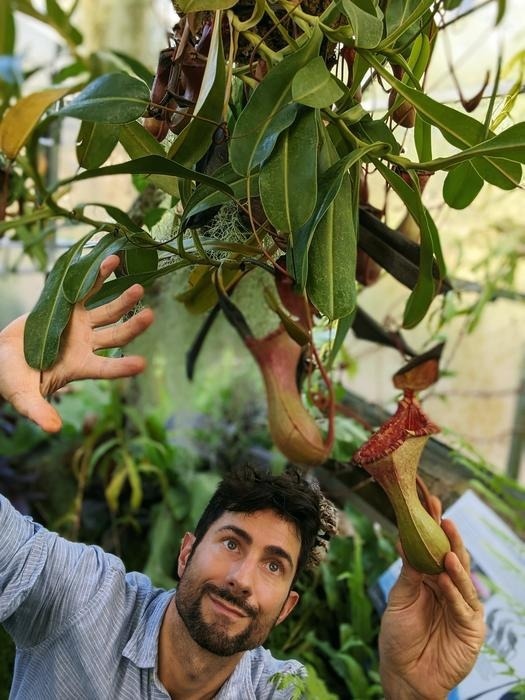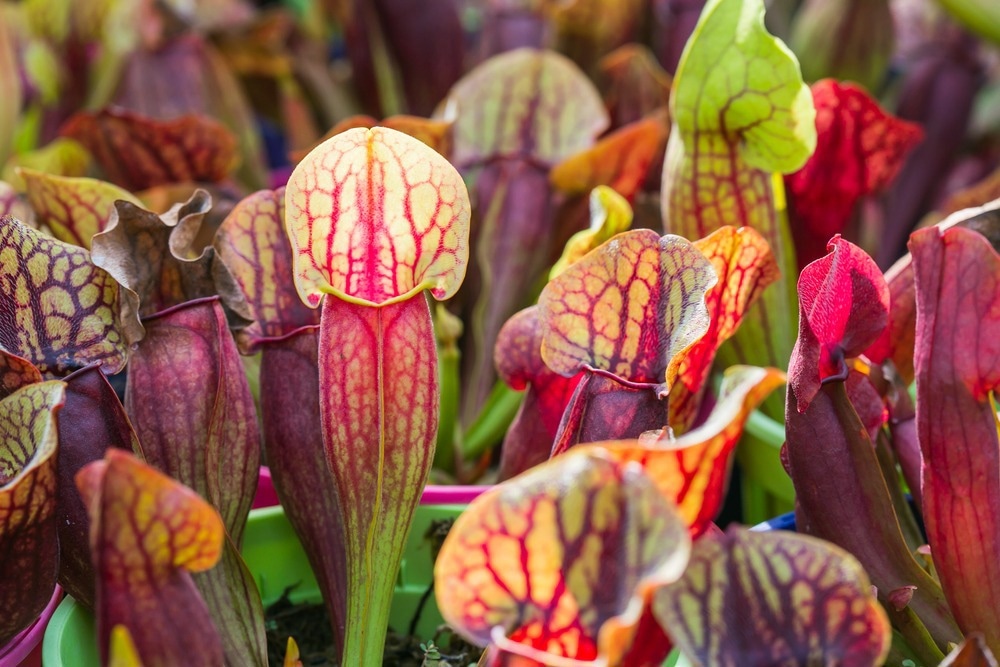The form, size, and geometry of carnivorous pitcher plants dictate the type of prey they capture, according to researchers from the University of Oxford’s Botanic Garden and the Mathematical Institute. The findings were published in the Proceedings of the National Academy of Sciences (PNAS) on September 8th, 2023.
 Botanist Dr Chris Thorogood with pitcher plants at Oxford Botanic Garden. Image Credit: Chris Thorogood
Botanist Dr Chris Thorogood with pitcher plants at Oxford Botanic Garden. Image Credit: Chris Thorogood
Pitcher plants (genus Nepenthes) are carnivorous plants native to the tropics, particularly Southeast Asia. Their name comes from the hollow, cup-like structures they build to catch animal food (mostly insects). Pitcher plants exist in a wide range of forms and sizes, from tubes to goblets, and some even have spine-like ‘teeth’–but why they differ so significantly is unknown.
I first encountered these extraordinary plants in the wild in Southeast Asia nearly twenty years ago. I remember wondering: how and why do they vary so much? To have helped solve this mystery is truly exciting.”
Dr Chris Thorogood, Deputy Director, Oxford Botanic Garden, University of Oxford
The process by which pitcher plants trap prey is widely understood: each pitcher has a slippery rim at the top, known as a peristome, that is covered in ridges that accumulate a film of water. Similar to a car aquaplaning on water, this causes the prey to skid and fall into a pool of digestive fluids at the bottom of the pitcher.
Although this technique is shared by all pitcher plants, the rim form varies from basic cylinders to highly complex, fluted, or serrated constructions. The more ornate the rim, the more expensive it is to make; hence, why don’t all pitcher plants produce a basic structure?
To answer this question, the researchers used mathematical models on pitcher plants cultivated at the Botanic Garden to examine how the form of the rim affects prey capture. Shapes were grouped into four natural groupings and easily contrasted using mathematical reconstructions.

Image Credit: Tohsapol pongsomjit/Shutterstock.com
The capture efficiency of each design was calculated using a ‘point mass’–the equivalent of an insect slipping into the trap. The energy cost of creating the rim was then determined by comparing the relative size and steepness of the various constructions.
Mathematical reconstructions enable us to explore the trade-offs that exist in these plants in nature. Large, flared rims are costly for a plant to produce. By simulating both realistic peristomes and extreme versions—geometries that don’t exist in nature—we were able to show that in an optimal structure, the cost of production might be offset by the extra prey that can be caught.”
Derek Moulton, Professor, Applied Mathematics, University of Oxford
Dr Hadrien Oliveri, Postdoctoral Researcher at the University of Oxford’s Mathematical Institute, added, “A similar situation exists regarding trap size. We might expect the size of the rim to correlate with the prey most commonly available in a given habitat – be that ants or beetles, for example.”
To study the influence of trap size, the researchers created a mathematical model that connects the 3D geometries of pitcher plant rims with the physical mechanics of prey capture. The model included rim geometrical properties such as width, degree of flare, and orientation, as well as the stability and sliding direction of prey put at various points.
The findings indicated that differences in peristome geometries had a significant impact on what the plant could capture. The shape of extremely flared peristomes, for example, looked to be particularly adapted to collecting wandering insects such as ants.
Pitcher plants live in nitrogen-deficient settings such as mountain slopes, swamps, and tropical woods. This implies they have an advantage over non-carnivorous plants because of their capacity to collect nitrogen from captured insects. Each of these settings has a distinct mix of possible prey, raising the hypothesis that pitcher plants evolved a range of traps to capture the varied sorts of insects accessible in a given location.
Dr Thorogood stated, “Just as birds’ beaks are shaped differently to feed on nuts, seeds, or insects and so on these pitcher plants are well-adapted to the different forms of prey that exist in their environments.”
Despite their popularity, researching these ‘green predators’ in the field can prove challenging. As a result, mathematical techniques can be an effective tool to shed light on these botanical mysteries.
“Observing these plants in their natural environments is of course the best way to understand them. But many of these plants grow in remote, inhospitable places, so studying them in nature can be challenging,” Dr Thorogood noted.
Alain Goriely, Professor of Mathematical Modelling at the Mathematical Institute, further stated, “Working together is a powerful way for mathematicians and biologists to understand how and why such extraordinary organisms evolved, and to come up with new hypotheses. Mathematical modelling enables us to test them.”
The researchers want to continue their research on pitcher plants and other species produced at the Botanic Garden, which serves as a living library for scientists to study.
Source:
Journal reference:
Moulton, D. E., et al. (2023). Mechanics reveals the role of peristome geometry in prey capture in carnivorous pitcher plants (Nepenthes). PNAS. doi.org/10.1073/pnas.2306268120